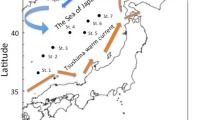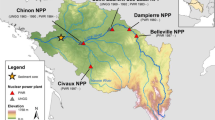Abstract
While debate continues about the disposal of man-made radioactive wastes in the deep sea, one deep-sea rhizopod is storing naturally occurring radionuclides to high concentrations in its home centimetres below the floor of the Izu–Ogasawara Trench. The hadal infaunal xenophyophore Occultammina profunda fills its test, a network of sediment tubes, with spherical micro-packages of waste (stercomes) containing 450–520 d.p.m. per g dry wt of the natural radionuclide 210Pb. The stercomes are stored in flimsy membrane tubes immediately next to a thread-like protoplasmic body (granellare), which has equally high 210Pb levels. A model of stercome excretion suggests that O. profunda grows quickly and can produce transient subsurface peaks in the vertical distribution of 210Pb in the sediment while causing little, if any, sediment mixing, a finding which could have profound consequences for the 210Pb-modelling of deep-sea bioturbation (mixing of sediments by organisms). From the barium content of the granellare (21,000 parts per million, p.p.m.) and assuming that the 226Ra/Ba ratio in the surrounding sediment and sea water is maintained in the organism, it is inferred that the protoplasmic 210Pb is supported by 320–350 d.p.m. per g dry wt of 226Ra concentrated in intracel-lular barite crystals. Consequently, O. profunda and xeno-phyophores in general are probably subject to unusually high levels of natural radiation (several Sv yr−1), among the highest reported for any living organism.
This is a preview of subscription content, access via your institution
Access options
Subscribe to this journal
Receive 51 print issues and online access
$199.00 per year
only $3.90 per issue
Buy this article
- Purchase on Springer Link
- Instant access to full article PDF
Prices may be subject to local taxes which are calculated during checkout
Similar content being viewed by others
References
Burton, W. M. & Stewart, N. G. Nature 186, 584–589 (1960).
Cherry, R. D. & Heyraud, M. Science 218, 54–56 (1982).
Nozaki, Y., Cochran, J. K., Turekian, K. K. & Keller, G. Earth planet. Sci. Lett. 34, 167–173 (1977).
DeMaster, D. J. & Cochran, J. K. Earth planet. Sci. Lett. 61, 257–271 (1982).
Yamsda, M., Kitaoka, H. & Tsunogai, S. Deep Sea Res. 30, 1147–1156 (1983).
Smith, J. N. & Schafer, C. T. J. mar. Res. 42, 1117–1145 (1984).
Cochran, J. K. Geochim. cosmochim. Acta 49, 1195–1210 (1985).
Tendal, O. S., Swinbanks, D. D. & Shirayama, Y. Oceanol. Acta 5, 325–329 (1982).
Tendal, O. S. Galathea Rep. 12, 7–99 (1972).
Tendal, O. S. & Gooday, A. J. Oceanol. Acta 4, 415–422 (1981).
Gooday, A. J. & Nott, J. A. J. mar. biol. Ass. U.K. 62, 595–605 (1982).
Black, S. C. Hlth Phys. 7, 87–91 (1961).
Sugiyama, M., Matsui, M. & Nakayama, E. J. oceanogr. Soc. Jap. 40, 295–302 (1984).
Spencer, D. W. et al. J. mar. Res. 36, 493–523 (1978).
Bacon, M. P., Huh, C., Fleer, A. P. & Deuser, W. G. Deep Sea Res. 32, 273–286 (1985).
Swinbanks, D. D. Science 218, 47–49 (1982).
Chan, L. H. et al. Earth planet. Sci. Lett. 32, 258–267 (1976).
Szabo, B. J. Geochim. cosmochim. Acta 31, 1321–1331 (1967).
International Commission on Radiological Protection, Publication 26, 53 (Pergamon, Oxford, 1977).
Blaylock, B. G. & Trabalka, J. B. Adv. Radiat. Biol. 7, 103–152 (1978).
Riemann, F. Oceanol. Acta. 6, 303–311 (1983).
Author information
Authors and Affiliations
Rights and permissions
About this article
Cite this article
Swinbanks, D., Shirayama, Y. High levels of natural radionuclides in a deep-sea infaunal xenophyophore. Nature 320, 354–358 (1986). https://doi.org/10.1038/320354a0
Received:
Accepted:
Issue Date:
DOI: https://doi.org/10.1038/320354a0
This article is cited by
-
Ecology of deep-sea meiobenthos in the western Pacific
Journal of the Oceanographical Society of Japan (1989)
Comments
By submitting a comment you agree to abide by our Terms and Community Guidelines. If you find something abusive or that does not comply with our terms or guidelines please flag it as inappropriate.



